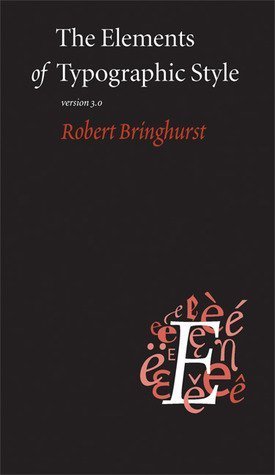The Elements of Typographic Style by Robert Bringhurst
My rating: 3 of 5 stars
This book contains more than I’ve ever wanted to know about typography. It describes not only how to use fonts, but also how to create them, explaining the math and science involved in font design. It also describes techniques for laying out text on pages. It reveals the history of typography from the days of clay and early paper, to the invention of the printing press, to modern digital typography. Bringhurst has a relaxing, elegant writing style that’s a pleasure to read.
I wanted to read a typography book because I’m using Web fonts more frequently in the websites I create. I chose this book because it was on the reading list of notable graphic designer Jason Santa Maria. I’ll admit that I skimmed large sections of the book that aren’t relevant to my work, including details on creating font faces, and the second half of the book which contains font face specimens and appendices.
Bringhurst makes several thought-provoking statements about typography. I liked these:
- "...typography must often draw attention to itself before it will be read. Yet in order to be read, it must relinquish the attention it has drawn."
- Typography should "invite the reader into the text" and "reveal the tenor and meaning of the text."
- "Consult the ancestors. Typography is an ancient craft an an old profession as well as a constant technological frontier."
- "...typography itself has not improved. There is no greater proof that typography is more art than engineering. Like all the arts, it is basically immune to progress, though it is not immune to change."
Rhythm & Proportion
- Single columns should contain 45-75 characters (66 are ideal). Multiple columns should contain 40-50 characters.
- "...avoid consecutive hyphenated line-ends, but frequent hyphens are better than sloppy spacing, and ragged setting is better yet."
- Use a single space after periods and other punctuation; don’t double-space.
- Add little or no space within strings of initials, such as "J.P. Morgan".
- In numbered lists, don’t put too much space between numbers and text.
- Don’t begin or end a page with isolated lines; use at least two lines from a paragraph.
Harmony & Counterpoint
- Use bold weights sparingly.
- Text weight should decrease as size increases.
Structural Forms & Devices
Titles should be spaced caps the same size and weight as body text. If using a large size for titles, use an upper- and lowercase titling font or lightened version of the body font.
Analphabetic Symbols
- Use the dimension sign instead of the letter "x" for dimensions.
- Use close-set en dashes to indicate a range, such as "5-6 PM" or "25-30 minutes". In prose, use the word "to" instead.
- Don’t use periods in acronyms and abbreviations written with small caps, like "AM", "PM", "Washington, DC".
Choosing & Combining Type
- "Choose faces that suit the task as well as the subject." Choose 1) an inherently good type, 2) a good type for the medium and how it will be read, and 3) a type that's sympathetic to the theme of the content.
- "Choose faces whose individual spirit and character is in keeping with the text."
- "Start with a single typographic family." For example, pair serifs and sans serifs from the same family. However, feel free to expand beyond that family, mixing and matching.
- "Pair serifed and unserifed faces on the basis of their inner structure. When the basic text is set in a serifed face, a related sanserif is frequently used for other elements..."
Shaping the Page
To invite continuous reading, use columns that are taller than they are wide.
The State of the Art
"Good text faces for the screen are therefore as a rule faces with low contrast, a large torso, open counters, sturdy terminals, and slab serifs or no serifs at all."

this is nice Information, thanks for sharing. Hope we will read many other good things from you in future also. Regards